- This topic has 17 replies, 7 voices, and was last updated 8 years ago by
 Michael O’Connell.
Michael O’Connell.
-
AuthorPosts
-
16 December 2017 at 10:53 pm #573905
 Bill WardParticipant
Bill WardParticipantHi,
Whilst planning for my most recent meteor observing trip to Tenerife I happened on an unusual image taken by Dr Jurgen Rendtel from the location of the observatory on Tenerife.
This showed a meteor with a distinct “corkscrew” shape. I had read about visual reports but these seem to have been dismissed as optical illusion. During a previous Geminid observing trip to Tenerife in 2012 I observed several bright meteors which seemed to oscilliate as they fell. I was sure what I’d seen was real but there was the doubt that it was indeed an optical illusion.
On my latest trip I recorded at least 10 (TEN) corkscrewing meteors! See some examples below…
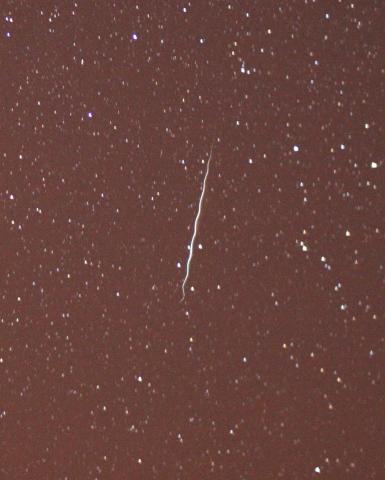
Geminid
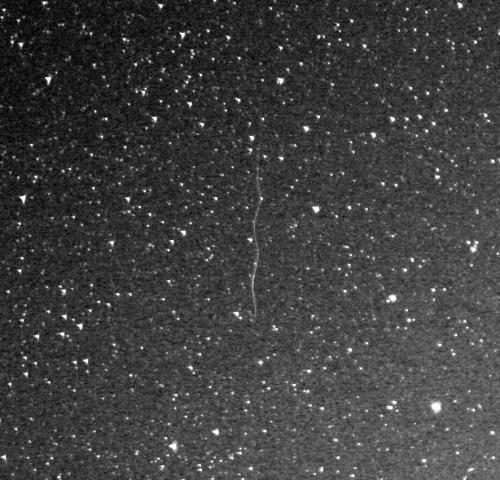
Geminid

Sporadic/other
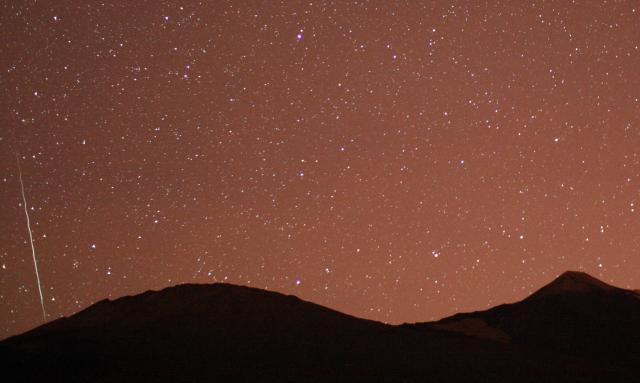
Geminid.
The first three are tight crops to get better detail, #4 is a wider shot. #1,#2 and #4 were taken with a Canon 1000D/30mm f1.4 @ f1.4/1600 asa/27 sec exposure. #3 was another 1000D/30mm f1.4/1600 asa but 43 second exposure.
The best theory I can think of is an off axis density or particular shape sufficient to cause rotation when impinging on the atmosphere thus when caught in an long exposure giving the corkscrew effect. Like half a sycamore seed as it falls and corkscrews around.
There are lots of other examples on line so it’s proof positive that meteors don’t necessariliy need to be “straight”.
Cheers,
Bill.
PS The spectroscopy was pretty good too, watch this space….
17 December 2017 at 8:26 am #578862 Nick JamesParticipant
Nick JamesParticipantOne other explanation which I have seen in practice on my images is wind vibration of the camera. This can have a negligible effect on the star images since they are integrated over minutes but show up very clearly on meteors which are only present for a fraction of a second. You even see this on trailed objects like minor planets in long exposure images. If this were a real, physical effect on the meteroid itself you should be able to calculate the transverse acceleration using the amplitude of the corkscrew and the presumed range and along-track angular rate. It would be interesting to see whether this looked physically reasonable given the kind of off-track lift force that you might imagine.
17 December 2017 at 4:48 pm #578863 Bill WardParticipant
Bill WardParticipantHi,
Yep it’s a curious effect all right. On twitter I’ve been presented with many explanations and reasons. The first night I was observing it was so windy I elected not to use the DSLRs for this very reason, 2nd night (peak) was much less windy although there were some short spells of gusty winds and the 3rd night was fairly windy again (but I haven’t got to checking all of the third night images yet!).
What would clinch it would be some double station imaging with suitably placed cameras. I’ll just need to go back to do some more imaging…. 😉
cheers,
Bill.
17 December 2017 at 5:09 pm #578864 Bill WardParticipant
Bill WardParticipantJust for completeness….
Here’s the full image of the first spiral image (I’ve re-sized the image but there has been no processing). Also, the next two meteors in this sequence from the night. 2nd is fainter, mid upper right (11 x 30 secs later) and 3rd was another bright meteor (a further 6x 30 secs later). If it was wind it would needed to have been very contstant to generate the identical oscillatory effect and in any case the whole rig was low down sheltered by a wall and the car. This still does not guarantee absolutely there was no wind effect but I did deliberately try to minimise it.
I might go with shutter slap but with that vibration, hopefully, dying down quickly it would mean ALL of the spirals would need to be caught just in the first few seconds as the mirror moved and the shutter opened. Again not impossible but the odds must be fairly long…
Next time I’ll be taking a tripod with tubular legs I can fill with sand to dampen out vibrations.
If nothing else it adds a bit of drama to the image!
Cheers,
Bill.
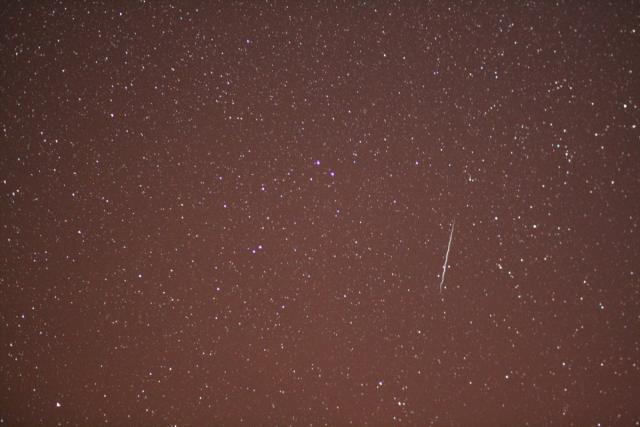
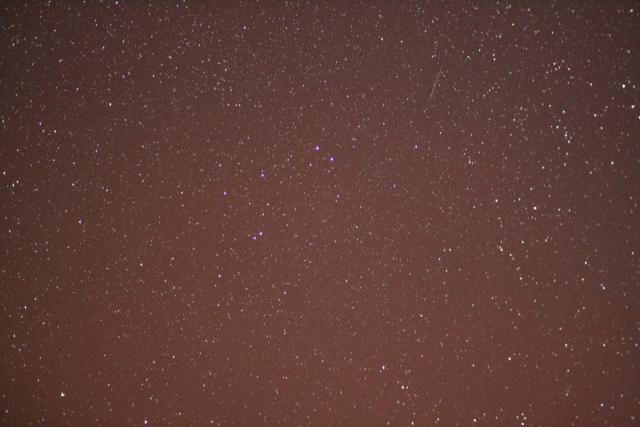
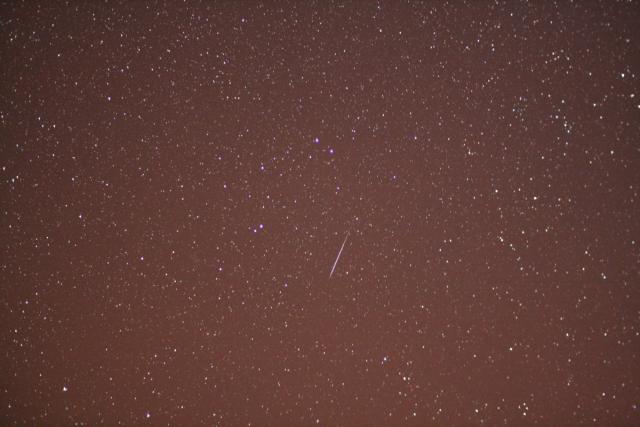 17 December 2017 at 5:28 pm #578865
17 December 2017 at 5:28 pm #578865 William StewartParticipant
William StewartParticipantHi Bill,
Does your DSLR allow you to lock the mirror in the up position?
William
17 December 2017 at 10:03 pm #578866 Bill WardParticipant
Bill WardParticipantHi,
I was using two Canon 1000D’s, don’t know if such economy models have this feature. I’ll check the manual just in case.
The peak night was just gorgeous but casual astro-tourism has turned the caldera into a motorway. 12/13th a few cars, 14/15th a few cars but 13/14th was ridiculous until around 0200. Every layby and track had cars jammed in. From the traffic I saw I’m glad I wasn’t actually at the observatory! It must have been chaos up that road.
When I left there was not a soul remaining, this was still an hour before twillight but I was frozen.
More importantly I got 10 viable spectra. Apart from the big fireball (twitter) the fainter ones show some interesting characteristics.
Cheers,
Bill
18 December 2017 at 5:09 pm #578867 Robin LeadbeaterParticipant
Robin LeadbeaterParticipantHi Bill,
My venerable 350D has mirror lock up so I suspect the 1000D will have. (buried in the setup menu,first press of the shutter moves the mirror,second press operates the shutter). It depends on focal length of course but the vibration was very obvious at 300mm fl when I forgot to enable it. Though so as you say unlikely to be the cause here unless the meteor was right at the beginning of the exposure.
Robin
18 December 2017 at 7:49 pm #578868 Nick JamesParticipant
Nick JamesParticipantI think corkscrewing meteors with this kind of observable transverse displacement are physically impossible.
A very hand-wavey argument goes as follows (although you might like to check my maths since I worked this out while cycling home tonight). Let’s assume the meteor has an entry velocity of 60 km/s and it decelerates to zero in 1s. That means it is visible for a track of length 30km. Your photos show around 7 cycles of wiggles with an amplitude of around 1/50 of the trail length, so let’s say 600m. That’s +/- 600m transverse displacement in 1/7s. Assuming the transverse displacement is sinusoidal the peak transverse velocity would then be 600*(2*pi*7) m/s and the peak transverse acceleration would be 600*(2*pi*7)^2. This would require a sinusoidally acting transverse force more than 40 times the along-track drag force. That is just not physically possible.
I still think the best explanation of this is wind vibration.
18 December 2017 at 8:21 pm #578869 john simpsonParticipant
john simpsonParticipantYes, 1000D does have this feature – in manual mode, under custom functions, screen 8.
john s
19 December 2017 at 12:34 am #578870 Bill WardParticipant
Bill WardParticipantHI,
Yep, indeed it does but when taking meteor shots one is taking sequences of hundreds of images. Unfortunately the manual says the mirror lock up works in what it calls “single shot” operation. It needs a two step operation to function and whilst that can be done with the canon remote control it can’t be done sequentially, automatically. Looks like it would need the observer to manually do the two press thing every shot. That would be VERY tedious after a short time let alone 6 hours!
I’ll just need to beef up the tripod and investigate further vibration mitigation for future field operations. IF the weather co-operates I’m going to run the same set up with the Quadrantids just to see how it behaves.
I am just so disappointed this could all be a mechanical resonance ;-))
Cheers,
Bill.
19 December 2017 at 2:26 am #578871 Robin LeadbeaterParticipant
Robin LeadbeaterParticipantI had a program on the laptop that operated the shutter automatically on a sequence including mirror lockup each time so did not need to manually operate it. It should not be too difficult to make up a little battery operated circuit to do the same thing though, closing the shutter remote contacts in a sequence
19 December 2017 at 9:06 am #578872 Bill WardParticipant
Bill WardParticipantHi,
That sounds like just the ticket! Do you have a copy of the circuit or a URL for such. Mentioning the 350D, I built a timer circuit using the venerable 555 chip so I could use long exposures on my own 350’s.
There’ll be a solution somewhere!
cheers,
Bill.
PS. It’s just occured to me I could probably do it with one of the Arduino’s I have, DOH!!!
19 December 2017 at 1:56 pm #578873 Robin LeadbeaterParticipant
Robin LeadbeaterParticipantI’ll see if I can dig out the program but it ran on XP via USB to the camera and ISTR there was no support for that when I moved to Win 7. Yep a couple of 555s would probably have been my choice back in the day. (a quick pulse to flip the mirror up then a couple of seconds delay to let things settle before starting the main exposure) but Arduino, Raspberry Pi, BBC microbit etc feeding a relay or optocoupler would do the job. I am surprised the cheap after market remote timers dont have a lock up facility but the ones I had a quick look at don’t seem to eg
https://www.amazon.co.uk/Neewer%C2%AE-Shutter-Release-Hasselblad-PowerShot/dp/B004FKYBJM/
19 December 2017 at 3:31 pm #578874 Roy HughesParticipant
Roy HughesParticipantHi,
Assuming that portability is important. I wonder if a stiff bungee cord attached to the tripod head and an ‘auger earth anchor’ (see GOOGLE) under the centre of tripod might hold things stable enough for your purpose? A bag full of sand (much beloved by eclipse chasers) might swing in the wind and be more of a hinderence than a help. But an auger would put the whole thing in tension, with the whole planet on the far end!
Roy
19 December 2017 at 3:37 pm #578875 john simpsonParticipant
john simpsonParticipantHi Robin & Bill,
I had a cheap-n-cheerful Qumox intervalometer which I used with 1000D for transit of Venus because I could programme in delays, exposure etc. I thought it had such a facility. If I remember rightly I could programme the timer with delay, exposure time, interval between shots and number of shots up to 999 I think. With 1000D set to ‘bulb’ and then switched to liveview the mirror came up then timer went through the sequence – delay – exposure – mirror dropped down and lifted again immediately- interval – exposure – mirror drop & lift etc. I’ll try to find it to check.
john s
19 December 2017 at 6:31 pm #578876 Robin LeadbeaterParticipant
Robin LeadbeaterParticipantHi John,
That’s interesting. On my 350D the mirror stays down after an exposure so always needs a double press of the shutter release at the start of each exposure. Perhaps it is connected with live view which the 350D doesn’t have. I rarely use my DSLR for astronomy but have just written a little program to do this for my BBC microbit, mainly for fun.
Cheers
Robin
19 December 2017 at 7:25 pm #578877 Robin LeadbeaterParticipant
Robin LeadbeaterParticipantHowever…. I have just discovered an apparently undocumented feature (ten years late!) that on the 350D if you select mirror lock up AND self timer mode, only one press is needed. (Mirror goes up, 3sec delay, exposure starts) so a standard intervalometer should do the trick even on the 350D (and perhaps other models too?)
23 December 2017 at 11:54 am #578889 Michael O’ConnellParticipant
Michael O’ConnellParticipantHave you looked into installing Magic Lantern firmware add-on to the camera?
-
AuthorPosts
- You must be logged in to reply to this topic.
